Blog post by Mikko Ijäs, retreat organizer
We held our first Bearing Witness retreat here in Helsinki in late June 2018. The context of the retreat was set around the prison camps of the Finnish civil war of 1918.
One hundred years ago Finland was torn in half by two opposing forces, the Whites and the Reds. The brutal conflicts and mistreatment of the prisoners soon ended, but the legacy of this tragedy that claimed one per cent of the whole population has continued to this day.
Over eleven thousand people died in the prison camps hastily established for the Red captives waiting for their trials.
The retreat was composed around three main locations: the Suomenlinna fortress island just outside Helsinki, Dragsvik garrison in Tammisaari, and Hennala garrison in Lahti. All of these locations had prison camps from 1918 to 1919. Actually Dragsvik continued to function as a correctional institute for the political activists until the Second World War. These camps represent only three of more than ten camps established to accommodate the c. 80,000 captives that were rounded after the fighting stopped.
The winning side of the conflict, the White Guard and the Germans, had no idea of the numbers of their opponent. The huge crowds of the captives really posed a big problem for them. The detainees were sent to improvised concentration camps (actual word that was used for these camps in 1918) to wait for their trials. The poor maintenance and lack of supplies resulted in thousands of unnecessary deaths. These camps were guarded by Finnish and German officers, and often there were summary executions even for the very young women.
These camps were the first concentration camps in Europe.
I was struck by how much we Finns still tend to take sides. The dual nature of the civil war is still alive in most of us. I am a mix between different backgrounds of Whites and Reds, but as I was thinking the ways to improve the retreat for upcoming years, I noticed how I couldn’t think anyone “sensible enough” to speak about the Red terror of civil war. Even after one hundred years, I categorized these people into sensible and insensible!
When I went to school, we were taught that WW2 was a zeroing point in our history. The war brought us together, and old tensions were finally buried. The civil war was described as a victorious war of freedom from Russian forces. The Reds were portrayed as Russian bolsheviks accompanied by renegade factory workers.
People from opposing backgrounds spoke about class war, red rebellion, liberation war. It wasn’t until the very late 20th century when more neutral terms as civil war began to emerge.
The civil war where churned up by various difficult factors. The whole country was in turmoil after the revolution in Russia in 1917. Finland began to work for their own independence and declared its independency in December 1917. Political disputes, and other factors lead into the civil war in January 1918. The reasons behind it are complex, and the colorful groups of people from various backgrounds, calling themselves as Reds, was inflicting serious terror among the rest of the population. This rebellion had to be dealt with, but the result was even worse. The political witch-hunts continued until the WW2. After all this time, it is amazing how we still identify on either side. Our retreat participants identified themselves being on both sides or being a mix of both.
Revealing this side of myself is something that I certainly have to work with. This matter will also be addressed more thoroughly when we have another retreat next year in early July 2019.
During the week the retreat was also covered by the Finnish media. The public broadcasting company YLE have already been publicly criticized because of this. Someone felt covering this retreat was marxist propaganda.
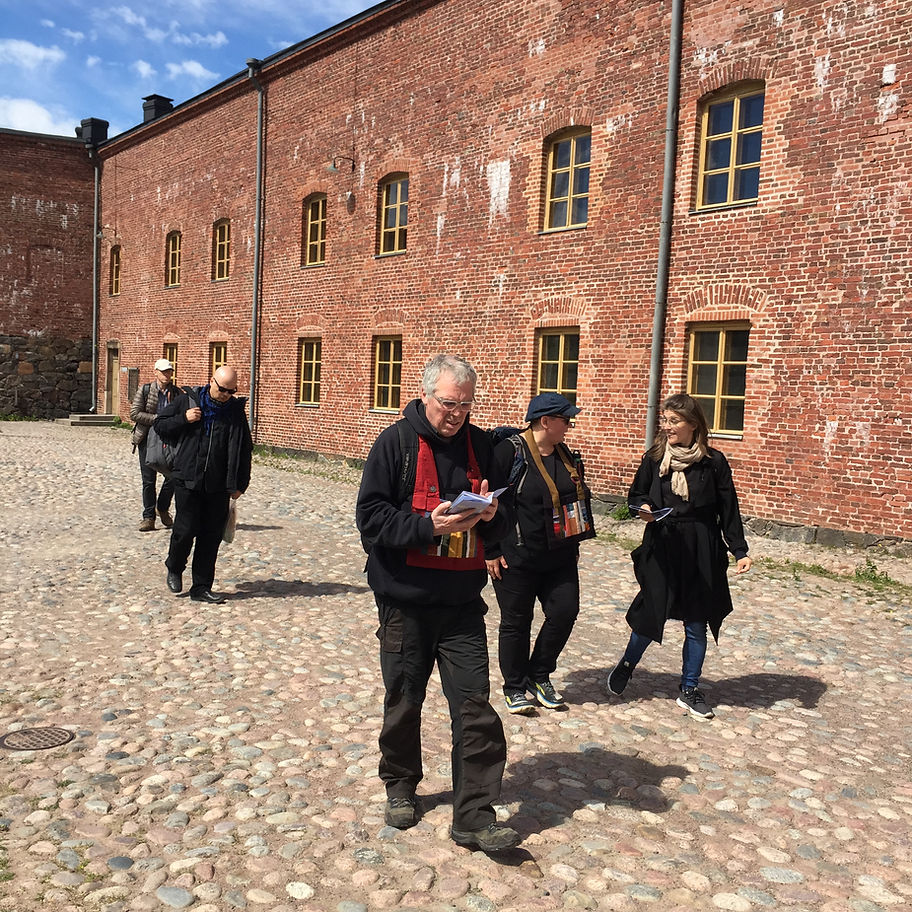
IMAGE: Retreat leader Roshi Frank De Waele, retreat organizer Maija Ijäs and local spirit holder Lutheran priest Maika Vuori visiting one of the civil war prisons at Suomenlinna fortress island, Helsinki.
DAY 1.
The first day of our retreat began at the Church of Kallio, which is the former working class neighborhood and the center for red rebellion in 1918. Our retreat leaders Roshi Frank De Waele from Belgium, and the local spirit holder Lutheran priest Maika Vuori introduced themselves. Roshi Frank spoke about the Three Tenets of the Zen Peacemakers and the different elements that comprise the bearing witness retreats, which originates in 1996 when the Zen Peacemakers had their first bearing witness retreat at Auschwitz-Birkenau in Poland.
During the retreat we visited different monuments, memorials, and places of great grief and sorrow. We had moments for silent reflection, we had Buddhist and Christian services, and we practiced the Way of the Council, a kind of listening circle, which is a pivotal element of the retreats by the Zen Peacemakers. We didn’t visit the different locations alone. We also had people describing the history of these sites, and telling the stories of the people who were once placed there.
On our first day we visited the former prison camp at Suomenlinna fortress island just outside the city center. It once had about 8,000 Red detainees. At Suomenlinna we were accompanied by sociologist Sari Näre, PhD, who has written a book titled “Helsinki veressä“ (Helsinki in Blood) in which she paints a vivid image of the horrors the White and the German soldiers inflicted as a revenge on the Red captives. Dr. Näre spoke about passive killing that was prevalent in many of these camps, but especially in Suomenlinna. She described how prisoners were starved to death on purpose, and how drinking rainwater flowing from the chutes was punished.
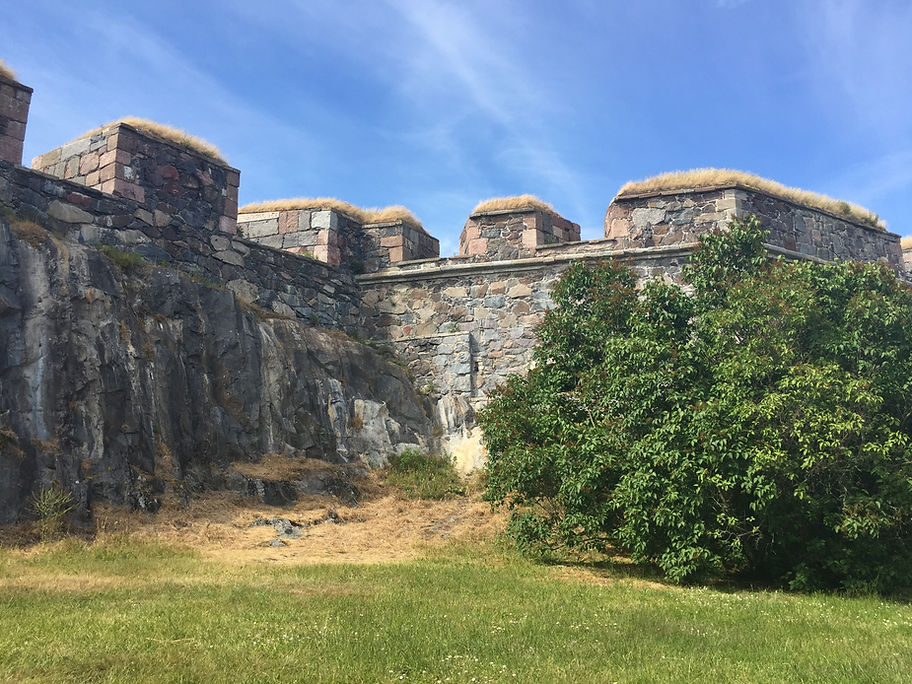
IMAGE: One of the 1918 execution sites at Suomelinna, Helsinki.
We held the “Gate of Sweet Nectar” ceremony at the Old Church Park at central Helsinki. This park has monuments for the White victims of the Civil War, but also for the German victims fighting on White side. The ceremony is based on ancient Buddhist liturgy with some interfaith elements. It is performed to commemorate those who are no longer here, and to call out those aspects in life that are neglected and forgotten. It is also performed to call out and feed the hungry spirits, and all forgotten and neglected aspects in ourselves.
Esad from Bosnia
At the end of our first day we had a very rare chance to hear the testimony of Esad Landzo from Bosnia. He was invited to speak for this retreat due to his very rare experience of being on the side of the perpetrator. During the Bosnian war in 1990’s he was one of the guards of the infamous Celebici prison camp. He was a member of a renegade squad of Bosniaks who had set up a camp for Bosnian Serbs. This group was a band of misfits who drank and tortured their detainees. Born in 1973 Esad was 19 years old when it all happened.
He was charged by the International Criminal Tribunal for the former Yugoslavia (ICTY) for willful murder, torture, causing intense suffering or of inflicting serious bodily injury, and inhumane treatment. He was sentenced for 15 years in prison here in Finland.
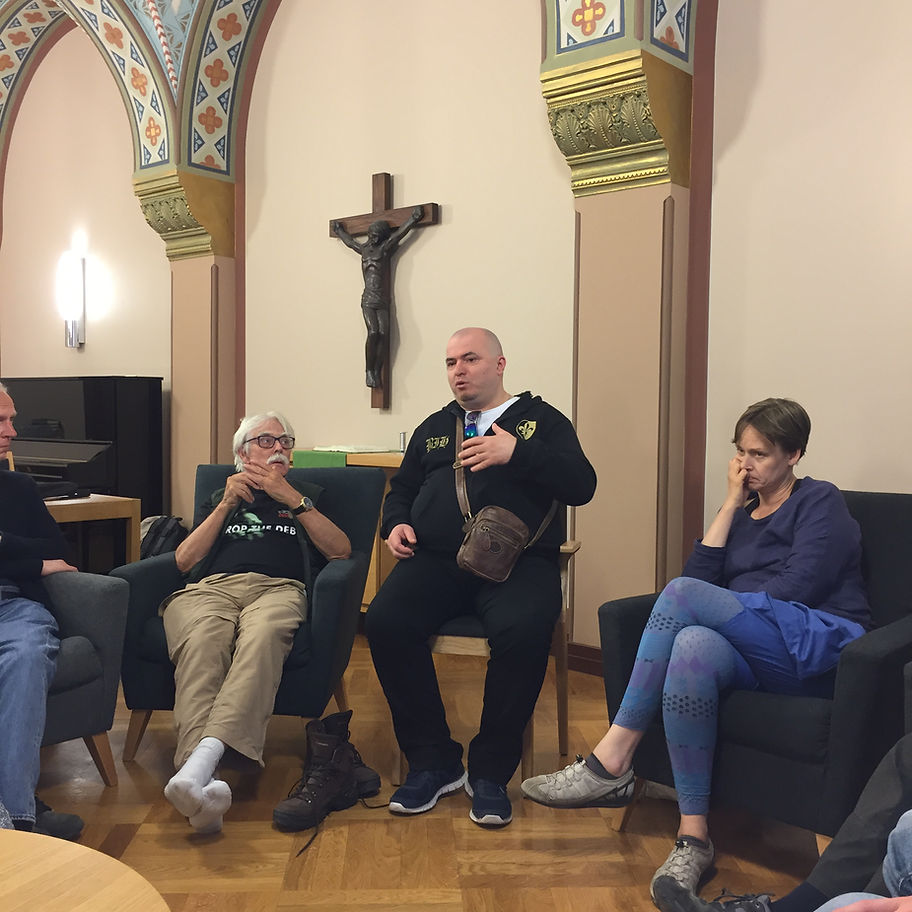
IMAGE: Esad Landzo speaking about his experiences, with retreat participant professor Tapio Lampinen and retreat organizer artist Johanna Hammarberg. Annankulma, Helsinki.
What makes Esad so special is his radical approach to his own actions. When he was put on trials he had no remorse. He was raised to do what he did. He described us that one of the biggest problems was that he had no fear. He had no supreme power to be afraid of. Rather, taking someones life made him feel like he was God himself.
But something changed in him when he was shown compassion by his attorney and her family. This was the first contact to people, who were not corrupted by the war and violence. Given this chance, it made him re-evaluate his own past actions. He accepted all psychiatric help that was provided for those who were willing to have it. This process began his path towards accepting his own past actions, and his search for forgiveness.
Esad’s painful process was beautifully portrayed by Danish documentarist Lars Feldballe-Petersenin in his documentary film “Unforgiven” (2017). This documentary describes his path to ask forgiveness from his former victims in Bosnia.
Esad’s radical approach to his own past was really moving. It was also really necessary, since I believe it is extremely important to illuminate the suffering from all sides of these conflicts. It is ofter forgotten how the so-called perpetrators will suffer from war. Esad really made this aspect alive. Although there might be a winning side in a conflict, it doesn’t mean that the winners would not suffer. In Finnish case the White Guard had to execute or detain their own family members, and in some cases, see them die slowly on these camps. Everyone suffers from war. Violence transforms everybody.
Esad had once met a woman in Denmark, who came to thank him. She told how her own father had been a guard on one of the German concentration camps. He had been unable to speak about his experience. The only way he could express his suffering, was through violently abusing his own children. She told Esad how thankful she was for Esad’s testimony and the actions he had taken for reconciliation.
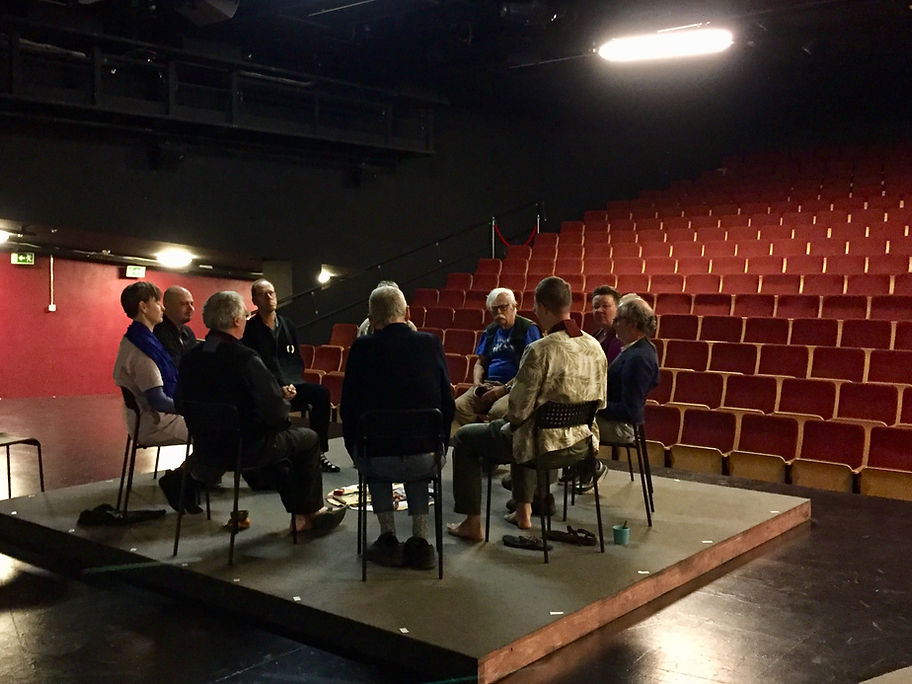
IMAGE: Council circle at Ryhmäteatteri, Helsinki
DAY 2.
The second day of the retreat began at Ryhmäteatteri, which is a independent professional theater in Kallio. We set up our Council Circle on their stage. The council was followed by breakfast buffet set up at the theater’s café. After the breakfast we had a bus to Tammisaari were we spent most of the day bearing witness to Dragsvik, the most notorious prison camp of the Finnish civil war.
The Russians built the garrison in the early 20th century, but after Russian revolution the army left it empty. These garrisons were occupied by the White Guard and the German troops in 1918. The staff arrived to the empty garrison with their prisoners. No preparations were made. The prisoners wondered around the garrison trying to find water and a place to rest. Drinking seawater only made matters worse.
Dragsvik prison camp is located about 100 kilometers west from Helsinki. It has a railway tracks passing just outside its gates. The tracks connect the camp to the east, west and north. The Germans came from the sea. It was an ideal place for prison camp; the convenient access through railroad, the old gate with barbwire, the sauna acting as delousing complex, the execution site behind the sauna, barracks built with red bricks… Its all like Auschwitz. There isn’t much research done on how much the Germans used these concentration camps as an example for what they did during the WW2, but it seems to be quite evident when you visit these camps.
People were not brought in to be killed. But that was exactly what happened. Almost 3,500 detainees of the 10,000 waiting for trials at Dragsvik were killed after few months. The prisoners had to stand in their barracks, since there was no room for lying down. Salted herring, rock hard bread (made using husks and tree bark), and very little water was only sustenance they had.
My maternal great-grandfather was detained for one year at the Dragsvik. He never spoke about his experience. He was truly ashamed of ever belonging to the Red guard. He probably had no choice. The workers of his neighborhood in Kallio were often given a choice of either joining the Red Guard, or being executed.
Forceful draftings might have been one of the reasons why it was so difficult to decide who was guilty of Red terror and who wasn’t. Ultimately, the Whites saw no other option besides imprisoning all possible suspects. It might be true that nobody expected or wished them to die. Sari Näre told us how the whole Finnish population was starving after we broke off from Russia. The ruling class had no intention improving the conditions of the detainees.
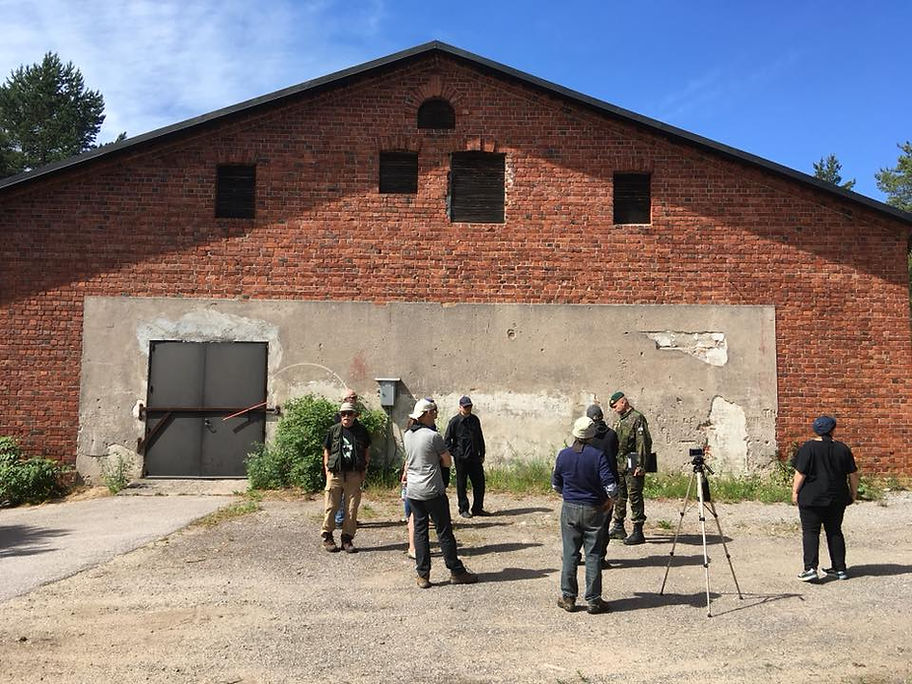
IMAGE: The execution wall behind the Sauna building at Dragsvik garrison, Tammisaari.
One of the retreat organizers and founders of the Peacemakers Finland, artist Johanna Hammarberg had done a sound piece earlier this year based on the letters written by the detainees of the civil war prison camps. The sound piece is a collection of twelve fictional letters based on actual published letters of the prisoners. The letters describe the conditions of the prisoners in a grueling detail. The letters were translated into English and read by Finnish actor Juha Valkeapää. The sound production was designed by Maija Myōshō Ijäs, who’s also one of the founders of the Peacemakers Finland and one of the key organizers of this retreat. After our lunch at the garrison, we sat down in a circle in a building, which was built as a church by the Russians, but it had functioned as a food storage during the prison camp era. The experience of listening the pleads and cries of these prisoners at one of the most horrid camps of that time was a powerful experience.
The mass grave for more than 3,000 detainees is located just outside the garrison. It is placed between two noisy roads. The site had been untouched until 1951 when the communists monopolized the memory of this site. We sat there for awhile in a circle reading the names of the people buried at the mound. Then we were lead into prayer by our local spirit holder Maika Vuori.
On our way back to Helsinki we made a stop at Inkoo. There’s a memorial site know as Västankvarn placed deep into the woods. It’s a location where more than 60 red victims were executed in May 1918. It’s a very peaceful site commemorating these victims. We performed the “Gate of Sweet Nectar” ceremony here.
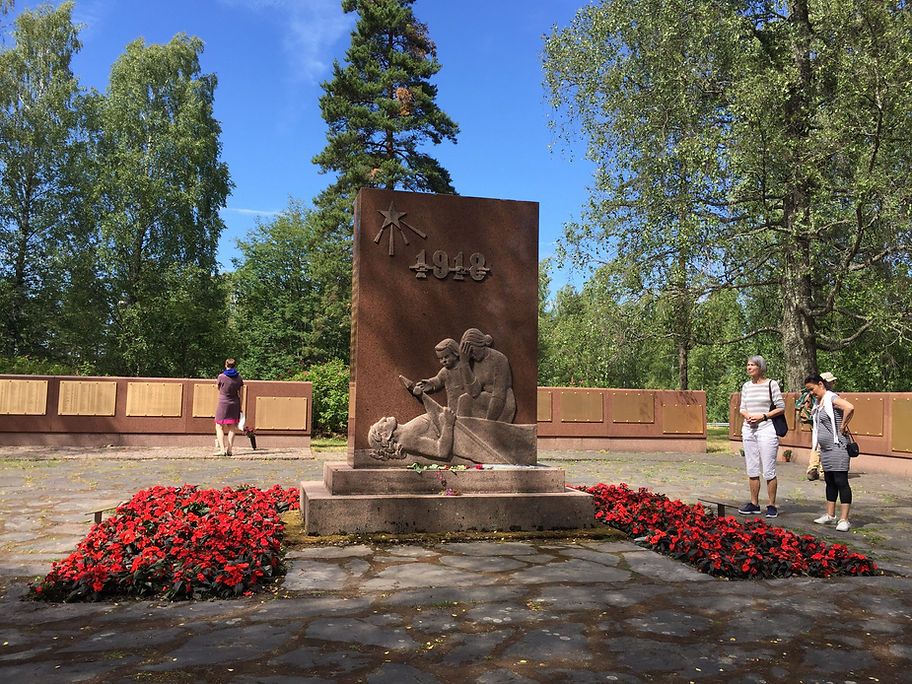
IMAGE: Massgrave memorial, Tammisaari
DAY 3.
The third day began at the theater with Council. After breakfast we boarded the bus and head up north to Lahti. The city had two of the biggest concentration camps after the civil war in 1918. About 22,000 fighters and civilian refugees were rounded up at the Fellman fields after the battles ended. Few days later about half of them were set free, but half of them were sent to Hennala garrison, and other camps including Dragsvik.
Retired UN Peacekeeper Seppo Toivonen who had spent most of his life at Hennala was our guide that day. The camp was made famous by author Väinö Linna in his trilogy “Under the North Star” and more recently by Marjo Liukkonen, Phd, who has studied the female violence at the camp.
We payed a visit to the site of the mass grave. This was just a place in the woods behind the barracks. After the civil war the city was building a new road across this area and they found this site. The whole ground was filled with bones and skulls. Nobody knows exactly how many had been executed, and how many had just died due to the bad conditions of the camp. The estimates vary between 800 and 900.
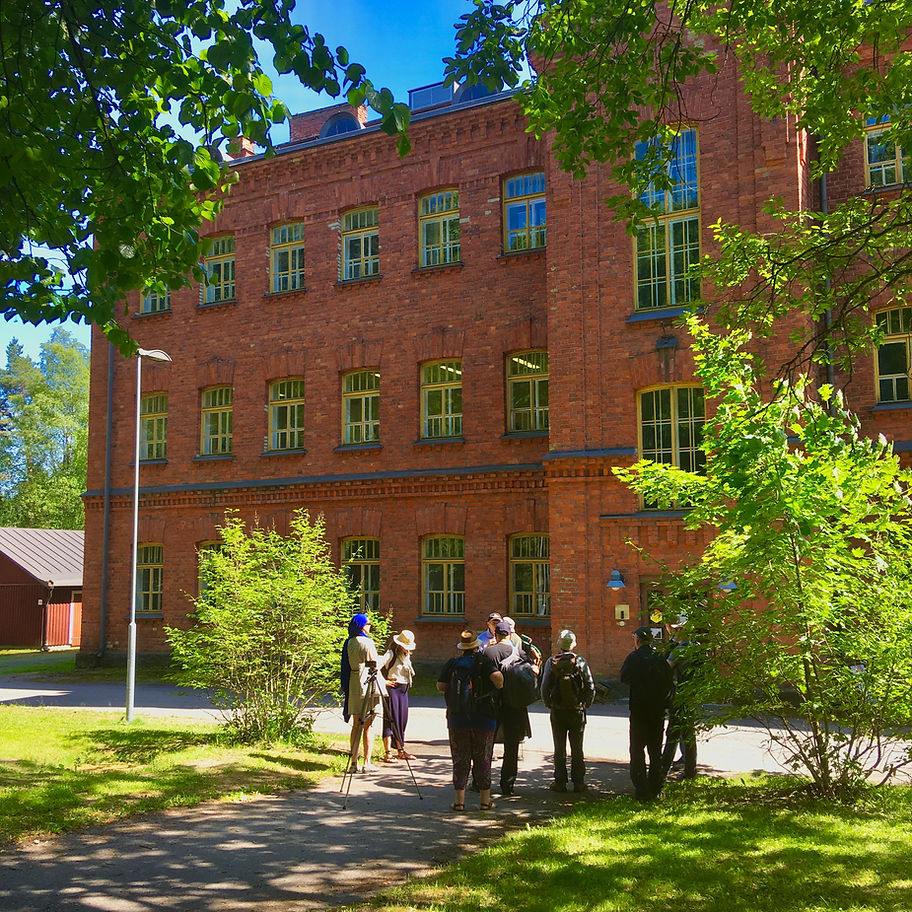
IMAGE: Building number 5 in Hennala, which was one of the prison barracks in 1918. Hennala, Lahti.
The long walk from Fellman park leading across Hennala garrison ended up at the southern most end of the camp. There’s a Russian orthodox prayer room and its wall had been used for executions. The two priests participating the retreat lead us into prayer by the site.
The day ended at the Temppeliaukio Church, where we had Council. We were all rather silent after the day. Hennala left us exhausted and empty.
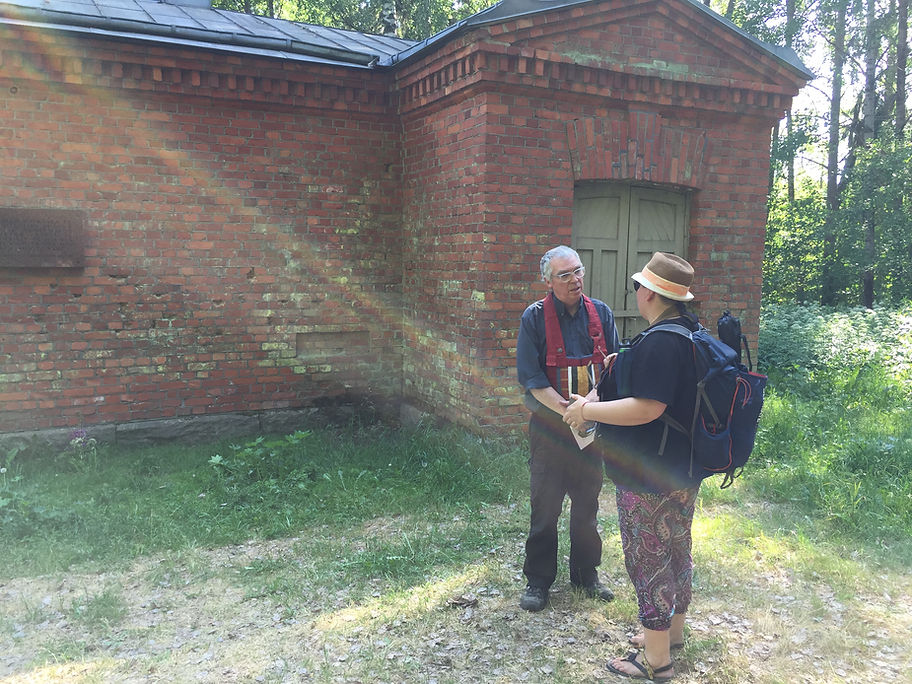
IMAGE: Roshi Frank and Maija next to the Russian prayer room that served as an execution site in 1918. Hennala, Lahti.
DAY 4.
The last day of the retreat was designated for reflection. We had more time for our breakfast. We prepared our lunch bags and set out in to rain. We walked through Kallio and passed the buildings were many of the Reds had lived, including my maternal family. After about half an hour we got to the monument for the red victims of the civil war. It is the only one in Helsinki and it is placed behind the Olympic stadium outside the city’s center next to a busy road. It is quite isolated, invisible and unknown. We were all struck by a recent graffiti on the monument. Someone had spray painted a text on it saying “Finland is White”.
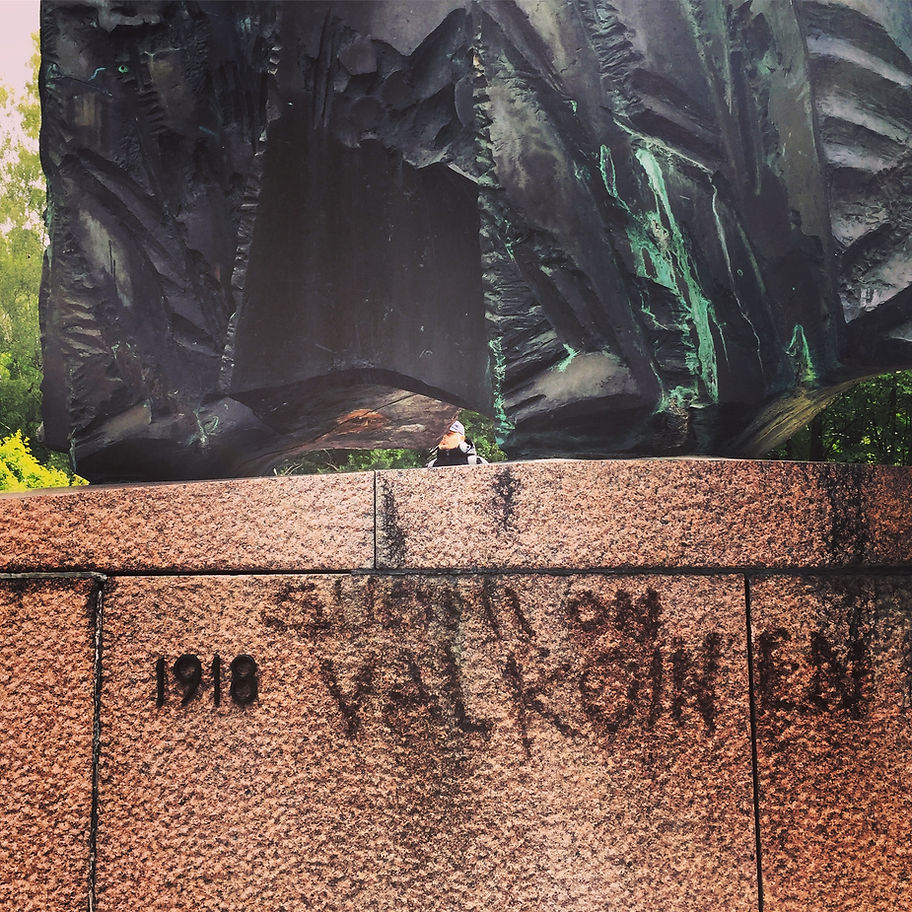
IMAGE: Someone had painted the text ”Finland is White” on the Red memorial. Helsinki.
We ended our retreat at the local Deaconess Institute. We saw an exhibition of their role during the civil war, and we had a moment of silent reflection at their chapel.
The institute also works with refugees and homeless. The Peacemakers Finland has been organizing monthly gatherings at their Citizens’ Arena, which is a public place and a living room for the residents of the whole complex.
That’s where we sat down for our final Council and performed the “Gate of Sweet Nectar” one more time.
The retreat will be held again in July 2019.
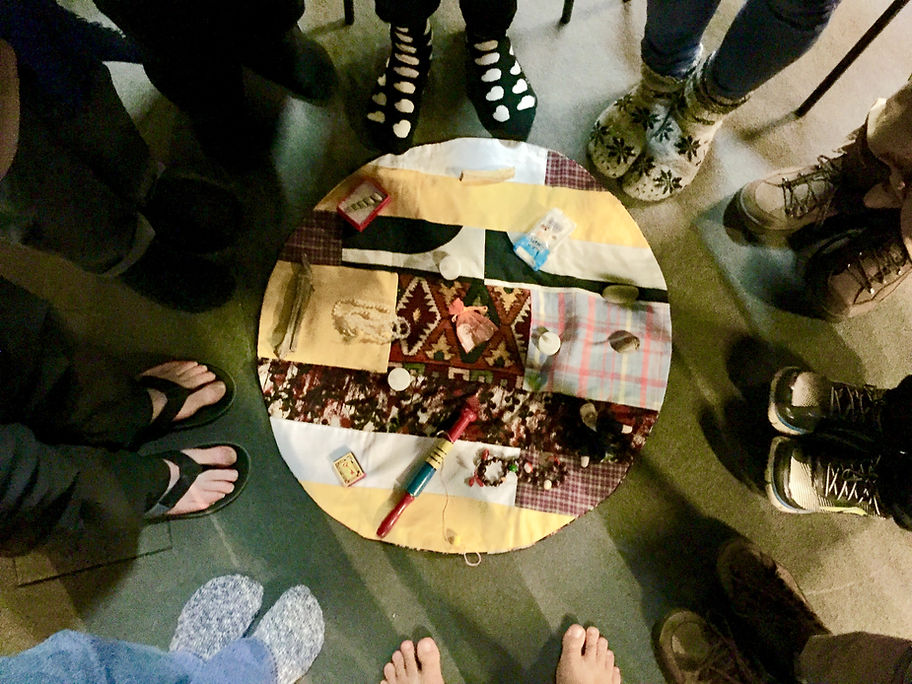
IMAGE: The center of our Council circle. Helsinki.